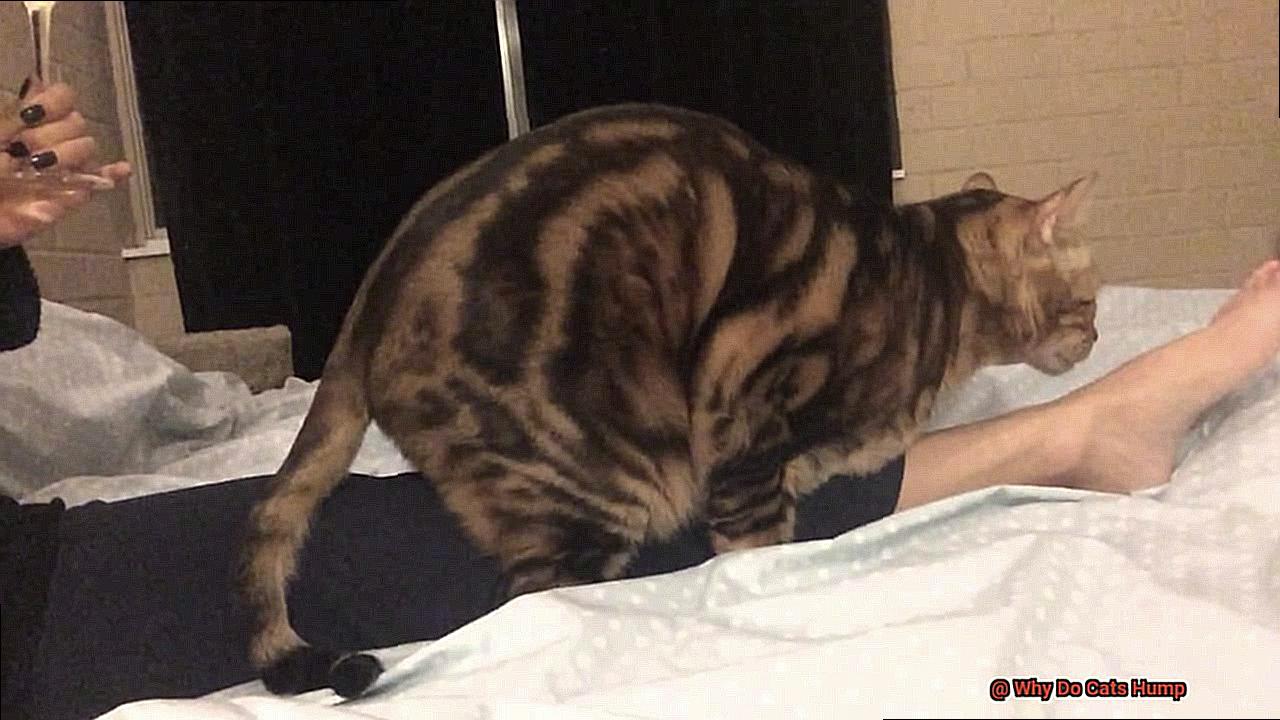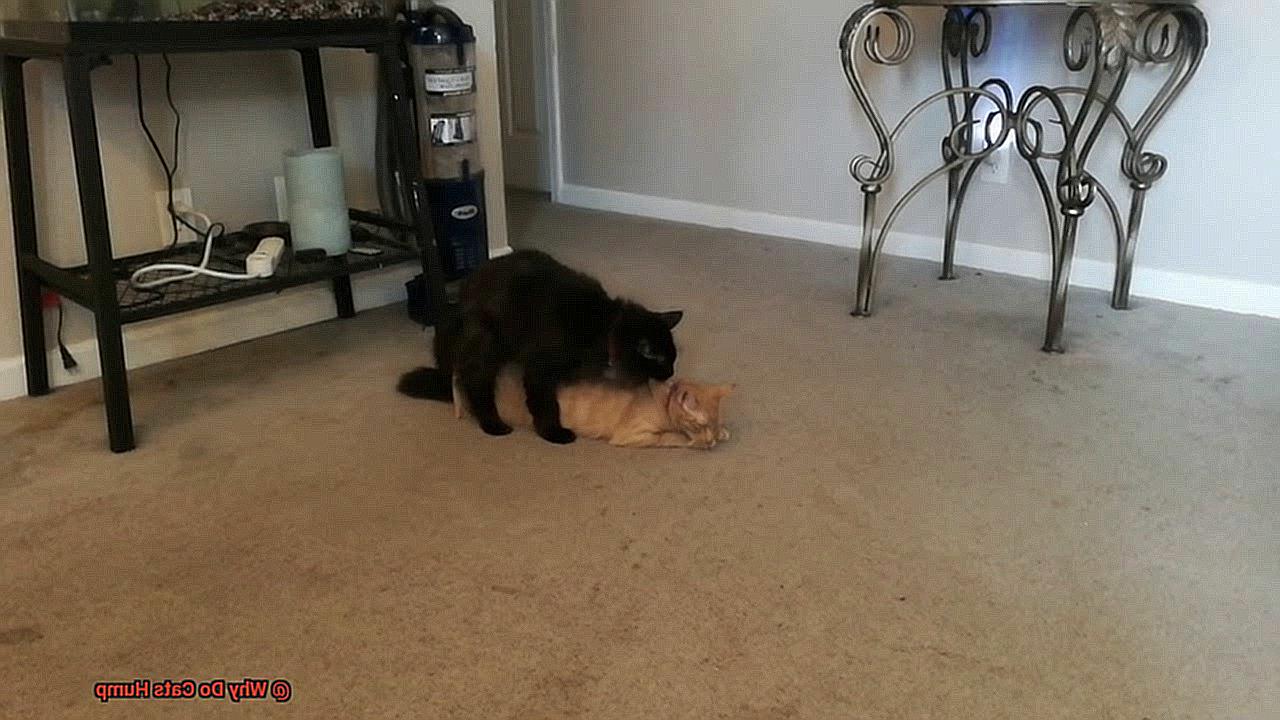Cats are captivating creatures that have been adored for centuries for their grace, independence, and mysterious personalities.
However, there is one behavior that can leave even the most experienced cat lover confused: humping. Yes, it’s true – just like dogs, cats are also capable of engaging in this peculiar behavior.
But what causes it? And what does it mean?
If you’re a cat parent, chances are you’ve witnessed your feline friend’s humping antics at some point – whether it’s a cushion, a fluffy toy or even your own leg. It can be both entertaining and bewildering, leaving many pet guardians wondering about the reason behind such behavior.
In reality, there are various reasons why cats may hump. Some do it out of habit or as a way to assert dominance and mark their territory.
Others may do so when they feel stressed or scared while some may find it pleasurable. In this article, we’ll delve deeper into the underlying causes of feline humping behavior – from behavioral triggers to potential motivations behind it.
So whether you’re a devoted cat parent or simply an animal enthusiast seeking answers about feline behaviors – keep reading to discover more about why cats hump.
What is Cat Humping?
It might be one of the quirkiest behaviors of our feline friends, but it’s a natural instinct linked to sexual behavior.

When a cat is in heat, they may display humping behavior as a way to seek out a mate. However, even neutered cats may still exhibit this behavior due to residual hormones or as a form of dominance or play.
This behavior is more commonly seen in male cats, but female cats can also exhibit this behavior. It’s important to note that cat humping should not be confused with aggression or territorial behavior.
While it may be disruptive or uncomfortable for owners, it is not a sign of aggression towards them. Cats may also hump as a result of anxiety, fear, or stress.
They can participate in this activity as a way to cope with their emotions. As such, it’s important to address this behavior by stress-reducing strategies and behavior change.
In multi-cat households, one cat may try to establish their dominance over the others by humping them or objects in the house. It’s essential to ensure that your cat is safe and secure in their environment and address any underlying causes of stress or anxiety.
Reasons Why Cats Hump
It may seem peculiar or even amusing, but it’s essential to understand the underlying causes of this behavior.
One of the most common reasons for cat humping is sexual activity, which is more frequently observed in unneutered male cats. However, neutered males and females can also engage in this behavior.
It’s their natural instinctual response to mating. Cats may also hump as a form of play or attention-seeking behavior.
They may use this tactic to initiate playtime with their owners or other cats. It’s also a way for them to get attention from their owners or assert dominance over other cats.
Stress and anxiety are additional factors that cause cats to hump. This behavior can be a self-soothing mechanism for cats who are feeling anxious or stressed out.
It can also be a way for them to release pent-up energy or frustration. Medical issues such as hormonal imbalances, neurological disorders, or pain in the genital region can also trigger cat humping.
If your cat engages in this behavior frequently, it’s essential to seek advice from your veterinarian or an animal behavior specialist to identify the root cause and provide appropriate solutions. It’s worth noting that while cat humping isn’t necessarily harmful, it’s critical to address any underlying problems that may be causing the behavior.

Signs of Sexual Arousal in Unneutered Male Cats
These behaviors can be quite obvious, such as increased restlessness, constant vocalization, and marked territorial behavior with urine.

You may also notice that your cat becomes more affectionate towards other cats or objects in the home. Physical changes are also common with sexual arousal in unneutered male cats.
An erection, swollen testicles, and an unmistakable strong odor may be noticeable. But what about when your cat starts humping objects or people?
This instinctual behavior is their way of releasing sexual tension and doesn’t necessarily indicate any attempt at mating or attraction to the object of their affection. If you see these signs in your unneutered male cat, it’s highly recommended to get them neutered.
Neutering not only prevents unwanted litters but also reduces the risk of health issues such as testicular cancer. By taking this step, you can help prevent unwanted sexual habits and keep your furry friend healthy and happy.
Don’t hesitate to consult with your veterinarian about getting your cat neutered if you notice these behaviors.
Stress and Anxiety-Related Humping
This common behavior can be alarming, but it’s important to identify its underlying causes and find effective solutions.
Cats may resort to humping when they feel overwhelmed or overstimulated, particularly when their environment changes. If you notice your cat engaging in this behavior, it’s best to determine the root cause of their anxiety and address it accordingly.
Providing a safe and comfortable environment for your cat is crucial, with plenty of hiding places and access to high perches that offer a sense of security. Interactive playtime is another great way to reduce your cat’s anxiety levels.
Toys that stimulate their natural hunting instincts can help release pent-up energy and reduce anxiety. Engaging in playtime with your cat will also strengthen the bond between you and them, providing much-needed mental stimulation that can improve their overall well-being.
It’s important to note that scolding or punishing your cat for stress and anxiety-related humping behavior can worsen the situation. Instead, try redirecting their attention to a toy or engaging in playtime with them.
You’ll be surprised at how effective this approach can be. If you find yourself struggling to manage your cat’s stress levels or modify their behavior, seeking advice from a veterinarian or animal behaviorist may be necessary.
They can provide additional guidance on how to handle your cat’s stress levels and provide solutions for modifying their behavior in a positive manner. In conclusion, managing stress and anxiety-related humping behavior in cats takes patience and understanding.
Territorial and Dominance-Related Humping
Territorial and dominance-related humping is a common behavior seen in cats, especially in male cats, although female cats can also exhibit this behavior. Humping behavior is often seen when a cat is feeling territorial or dominant.
This behavior helps them mark their territory or assert their dominance over other animals or objects. It can also occur when a new cat is introduced into the household, and the resident cat feels threatened by the newcomer.
Stress, anxiety, boredom, or sexual frustration are common triggers for humping behavior in cats. Identifying the root cause of the behavior is essential to address it effectively.
To prevent territorial humping, ensure that each cat in multi-cat households has enough space and resources. This includes separate food bowls, litter boxes, beds, and play areas.
Providing appropriate toys and engaging activities can also help reduce boredom and anxiety. Neutering male cats can help reduce territorial and dominance-related humping behavior.
However, it’s important to note that neutering doesn’t always eliminate the behavior entirely. Male cats that were neutered later in life may still exhibit sexual behavior due to learned habits.
If your neutered male cat is still exhibiting humping behavior, seeking guidance from your veterinarian or a feline behaviorist is the best course of action. It’s important to discourage humping behavior towards humans as it can be uncomfortable and potentially dangerous.
Consistent positive reinforcement training can also help teach your cat more appropriate behaviors.
SkthbjtyzIQ” >
How to Address Excessive or Aggressive Humping
There are several ways to address this behavior and ensure your cat is living their best life.
Provide Appropriate Outlets for Energy
Cats are energetic creatures and need regular exercise and playtime to burn off excess energy. If your cat is humping excessively or aggressively, try increasing their daily activity level. Offer interactive toys and engage in playtime with them frequently, set up a scratching post or climbing tree, and ensure they have access to plenty of space to run and play.
Identify Triggers and Reduce Stressors
Pay close attention to when and where your cat is humping. If they tend to hump in response to certain stimuli, such as a particular toy or location, try removing or limiting access to these triggers. Additionally, reduce any sources of stress in your cat’s environment, such as loud noises or frequent disruptions.
Use Positive Reinforcement
Positive reinforcement can be an effective way to encourage good behavior in cats. Reward positive behavior with treats and praise, and redirect negative behavior with positive reinforcement. For example, if your cat starts humping aggressively, distract them with a toy or treat and praise them when they engage in appropriate behavior.
Seek Professional Help
If your cat’s humping behavior persists despite these efforts, it may be time to seek professional help from a veterinarian or animal behaviorist. They can provide additional guidance on how to address excessive or aggressive humping and help identify any underlying medical or behavioral issues that may be contributing to the problem.
Rule Out Medical Issues
It’s important to rule out any underlying medical issues that may be causing your cat to hump excessively. Some medical conditions such as hyperthyroidism or adrenal tumors can cause hormonal imbalances that lead to excessive humping. It’s best to take your cat to the vet for a check-up and discuss any concerns you may have.
In conclusion, excessive or aggressive humping can be a sign of stress or anxiety in cats.
By providing appropriate outlets for energy, identifying triggers and reducing stressors, using positive reinforcement, seeking professional help when necessary, and ruling out any underlying medical issues, you can help your cat overcome this behavior and enjoy a happier, healthier life.
Also Read: Why Do Cats Hump Blankets? – 21Cats.org
Conclusion
In conclusion, cats never cease to amaze us with their unique behaviors, including humping.
As a cat owner, it’s important to understand the underlying reasons for this behavior and address them accordingly. Whether it’s due to sexual involvement, playfulness, attention-seeking behavior, fear or dominance-related problems, determining the root cause of your cat’s humping is crucial.
Fortunately, there are effective ways to tackle excessive or aggressive humping in cats. Positive reinforcement training, reducing stressors in their environment and seeking professional assistance when necessary are all viable options.
By taking the time to understand your cat’s behavior and providing them with the care they need, you can ensure that they live a happy and healthy life.







